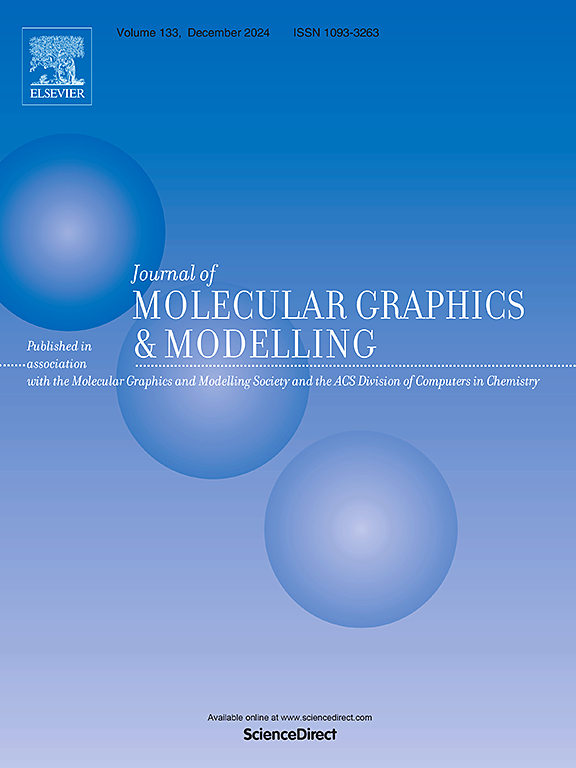Manipulating high Curie temperature of Sm/Ag doped ZnO monolayers by first-principles GGA+U study
IF 3
4区 生物学
Q2 BIOCHEMICAL RESEARCH METHODS
引用次数: 0
Abstract
This work studies the electronic structure, and magnetic properties of Sm/Ag doped ZnO monolayer by first-principles GGA + U calculations. The results show Sm-doped ZnO monolayer exhibits stable room temperature ferromagnetism with a high magnetic moment of 5.91 μB per unit. The total magnetic moment of the system is mainly contributed by Sm-4f, and the high Curie temperature results from the strong ferromagnetic coupling between the adjacent Sm atoms. The Ag-doped ZnO monolayers undergo magnetic quenching with the Ag doping concentration from 6.25 at.% to 12.5 at.%, which is extremely advantageous for designing and manufacturing magnetic switches. The ZnO monolayer shifts between the non-magnetic to the antiferromagnetic as the distance between neighboring two Ag atoms changes. In Sm-Ag co-doped ZnO monolayer, the Sm atom and Ag atom spin in opposite directions, and the magnetic moments partially cancel out, and the total magnetic moment of the system decreases. In addition, Sm/Ag mono-doped and Sm-Ag co-doped ZnO monolayer exhibited half-metallic behavior due to the impurity energy levels introduced in the bandgap by Sm/Ag dopant, and calculations of the formation energy show that dopants are prone to aggregate. This research may provide a reference for modifying the material properties of ZnO monolayers and designing nano-electronic and spintronic devices.

用第一性原理GGA+U研究Sm/Ag掺杂ZnO单层膜的高居里温度
本文采用第一性原理GGA + U计算方法研究了Sm/Ag掺杂ZnO单层的电子结构和磁性能。结果表明,掺杂sm的ZnO单层具有稳定的室温铁磁性,磁矩高达5.91 μB /单位。体系的总磁矩主要由Sm-4f贡献,高居里温度是由相邻Sm原子之间的强铁磁耦合引起的。当银掺杂浓度为6.25 at时,ZnO单层膜发生磁猝灭。%至12.5%。%,这对设计和制造磁开关极为有利。随着相邻银原子之间距离的变化,ZnO单层膜在非磁性和反铁磁性之间转换。在Sm-Ag共掺杂ZnO单层中,Sm原子和Ag原子自旋方向相反,磁矩部分抵消,体系总磁矩减小。此外,Sm/Ag掺杂和Sm-Ag共掺杂的ZnO单层由于Sm/Ag掺杂在带隙中引入了杂质能级而表现出半金属行为,形成能的计算表明,掺杂物容易聚集。该研究可为ZnO单层材料性能的改性以及纳米电子和自旋电子器件的设计提供参考。
本文章由计算机程序翻译,如有差异,请以英文原文为准。
求助全文
约1分钟内获得全文
求助全文
来源期刊

Journal of molecular graphics & modelling
生物-计算机:跨学科应用
CiteScore
5.50
自引率
6.90%
发文量
216
审稿时长
35 days
期刊介绍:
The Journal of Molecular Graphics and Modelling is devoted to the publication of papers on the uses of computers in theoretical investigations of molecular structure, function, interaction, and design. The scope of the journal includes all aspects of molecular modeling and computational chemistry, including, for instance, the study of molecular shape and properties, molecular simulations, protein and polymer engineering, drug design, materials design, structure-activity and structure-property relationships, database mining, and compound library design.
As a primary research journal, JMGM seeks to bring new knowledge to the attention of our readers. As such, submissions to the journal need to not only report results, but must draw conclusions and explore implications of the work presented. Authors are strongly encouraged to bear this in mind when preparing manuscripts. Routine applications of standard modelling approaches, providing only very limited new scientific insight, will not meet our criteria for publication. Reproducibility of reported calculations is an important issue. Wherever possible, we urge authors to enhance their papers with Supplementary Data, for example, in QSAR studies machine-readable versions of molecular datasets or in the development of new force-field parameters versions of the topology and force field parameter files. Routine applications of existing methods that do not lead to genuinely new insight will not be considered.
 求助内容:
求助内容: 应助结果提醒方式:
应助结果提醒方式:


